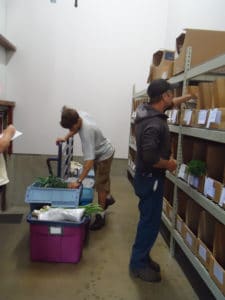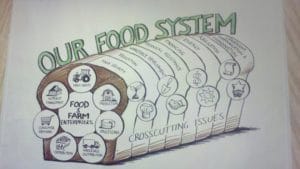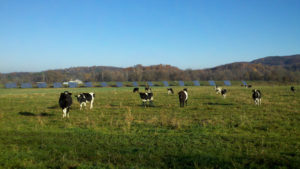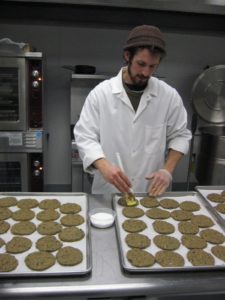Doubling Local Food in Vermont
Vermont Farm to Plate (F2P) Network unifies business, government & non-profits to scale up local food production & consumption by 2020

Jeff Smith of Smith Maple Crest Farm and Ryan Wood-Beauchamp of Evening Song Farm delivering food to Vermont Country Store as a part of the Farm to Work Program. Food from nine different farms is divided into order bins for the employees to pick up later in the day at their place of work. Photo by RAFFL
The Vermont Farm to Plate (F2P) Network is relocalizing food production and distribution in a statewide collaborative effort to rebalance the food system. A network of over 160 organizations encompassing all types and scales of agricultural-related production and processing are working together to execute the Farm to Plate Strategic Plan.
In 2009, the ‘Farm to Plate Investment Program’ was signed into legislation by then Governor Jim Douglas. The legislation tasked the Vermont Sustainable Jobs Fund with the creation of a ten year ‘Farm to Plate Strategic Plan’ to increase economic development in Vermont’s food and farm sector; create jobs in the food and farm economy; and improve access to healthy local food for all Vermonters. An economic impact analysis showed that every 5% increase in the consumption of locally produced food translates to at least $197 million in additional annual output and 1,700 new jobs. By supporting instead of duplicating existing efforts through a cross-pollinating network approach, the Farm to Plate Network is working to strengthen Vermont’s working landscape, build the resilience of farms, improve environmental quality, and increase local food access for all Vermonters.
Vermont has developed the most comprehensive food system plan in the country to date and the first in the New England states. All six New England states recognize that long term viability lies in regional food systems growth and each were represented at the recent Farm to Plate Network Annual Gathering, held in October at Lake Morey Resort in Fairlee, Vermont. A New England food system planning committee under the leadership of Food Solutions New England at the University of New Hampshire is convening to further cultivate conversations and share progress as each state begins to relocalize their own food system.
“Vermont leads the nation in direct-to-consumer farm product marketing, Farm to School programming, and community based agriculture. We are putting people back on the land to learn from it, work it, restore it, and steward it for subsequent generations,” Chuck Ross, Secretary of the Vermont Agency of Agriculture, Food and Markets commented at the start of the Gathering, where connecting across the 160-member Network and creating action plans were the themes of the two-day event.

A food system diagram on display at the Vermont Farm to Plate Network Gathering. Photo by Rachel Carter
At the start of the Network’s second year, new processes are being facilitated allowing for collaboration among players who are not usually in the same room with one another. Sodexo, the state’s largest food service provider, with contracts to serve all of the state colleges and two universities (serving 34,000 meals per day in aggregate), does not typically have regular conversations with local food hubs, processors, and distributors. From participating together in the Network, local relationships are developing to accelerate farm to institution purchases. A Sodexo “matchmaking” event held at the University of Vermont in November is helping small producers partner with institutions to determine the scaling up or down necessary on both ends to make for mutually beneficial relationships.
Farm to Plate Initiative Progress
In 2011 Fletcher Allen Hospital served more than 2 million meals, actually making hospital nutrition services the largest restaurant in Vermont. They partner with 70 local farmers and producers providing healthy, fresh, meals from scratch to patients while boosting the local economy. The hospital’s restaurant is actually one of Burlington’s most popular lunch spots to the general public.
Legislation passed in the spring of 2011 created the Working Lands Enterprise Fund and 15 Vermonters were appointed to the Board which will oversee investment in Vermont’s forests, farms, and agricultural producers. The Board is in the process of determining the funding criteria for grant proposals for $1 million in infrastructure development and technical assistance services in the coming year. Hopes are high that the Shumlin Administration and Legislature will approve elevated levels of funding in years to come.

Farm diversification from dairy development to energy production in Hinesburg, Vermont. Photo by Rachel Carter
Vermont Technical College’s Institute for Applied Agriculture and Food Systems received a $3.4 million federal grant in the fall of 2012 to serve the applied research and educational needs of agriculture, food production, waste disposal, and energy production businesses in the region through a cooperative education learning model.
Also in 2012, Vermont Law School established and hired a director for the Center for Agriculture and Food Systems to provide support, research, legal counsel, and leadership for community-based agricultural systems expansion.
Kingdom Creamery in Hardwick utilized the Vermont Farm Viability Program to diversify dairy farm production to premium ice cream, yogurt, and creemee mixes.
Self distribution grew to include Black River Produce and Vermont Roots, and channels are developing through the F2P Network with Sodexo. Additional collaborations with the Vermont Fresh Network to reach restaurants, the Vermont Grocers Association to reach independent grocery stores, and Farm to School programming to reach educational institution are strengthening dairy farm sustainability.
The Newport Fresh by Nature program launched this year as a downtown culinary designation of restaurants in Vermont’s northernmost community serving food harvested or produced within Newport and the surrounding rural communities. The participating farms offer farm visits and educational partnerships through Green Mountain Farm to School.
Black River Produce, the state’s leading fresh produce distributor, responded to Vermont and New England meat processing demands by purchasing the former Ben & Jerry’s plant in Springfield and is converting it to a meat processing facility. Scheduled to open in the spring of 2013, the facility will relieve current processing bottlenecks and create new market opportunities for local producers.

Joe Bossen of Vermont Bean Crafters producing bean burgers at Mad River Valley Food Hub. Photo by Mad River Food Hub
The Mad River Food Hub opened early in 2012 and offers meat processing, storage units, and business planning at its facility in Waitsfield to over 17 value added producers, like Joe’s Soups and VT Bean Crafters. The Food Hub also distributes fresh produce for local non-profit, Food Works at Two Rivers, an organization which provides nutrition training and farm-based agricultural education in the community.
As recognized by facilitators Curtis Ogden and Beth Tener at the annual gathering, the Farm to Plate networking approach navigates the multiplicity of organizations and missions and helps weed through “turfiness.” Erica Campbell, program director for the F2P Network comments, “Decisions are developed through a democratic process in the different working groups where everyone has a voice and can run with projects and ideas. Many of the organizations and groups represented are already working towards strategic plan goals. The Network provides a deeper platform to not duplicate efforts, but rather piggy-back and cross-market collaborative opportunities, business growth, awareness efforts, and relationships. The Network is based on an adaptive process which shifts based on progress and outcomes or lack thereof.”
The six operating working groups cover high impact leverage areas of aggregation and distribution, consumer education and marketing, technical assistance to producers and processors, education and workforce development, farmland access and stewardship, and dairy development.
“This self-governing collaborative made up of over 160-member organizations are working together to reach the 25 goals in the Farm to Plate Strategic Plan, as well as to advance their own organizations’ goals,” explains Campbell.
“Often, businesses and organizations get so busy with their day to day activities and work plans that they lose sight of the bigger picture. Working groups are meant to function at a higher elevation—viewing both the trees (specific strategies) AND the forest (how strategies interconnect). We really work to develop disciplined reflection during our meetings, so that we ask the bigger questions about what high impact projects can really move the dial in reaching our intended goals and outcomes,” offers Ellen Kahler, executive director of the Vermont Sustainable Jobs Fund which oversees the Farm to Plate Strategic Plan.
Kahler continues, “The Farm to Plate Network also has a number of cross-cutting teams which meet less frequently, including food access, financing, soils and water, research, and policy. These teams are meant to support the needs of all the working groups, since these areas of focus are relevant to all aspects of the food system.
As the F2P Network delves deeper into action to meet strategic plan goals, the final key component nears completion for an early 2013 launch. The Vermont Food Atlas will be a web portal which will feature a mapping interface of Vermont food system’s key attributes. An online database will provide people representing all areas of the food system the ability to locate and examine spatial relationships between farms, businesses, educational institutions, nonprofits and state entities. The Atlas will provide a communication and coordination forum for Farm to Plate Network members and an information clearinghouse of food system resources to be presented through industry relevant social networking capabilities.
The Farm to Plate Strategic Plan will be accessible through a searchable dashboard and a scorecard system will track progress in reaching the plan’s goals. The Atlas will provide the interactive tools necessary for the Farm to Plate Network to expand Vermont’s local food system and double food production and consumption by 2020.
Ellen Kahler perhaps puts it best when she says, “we’ve made incredible progress thus far because of our small size and the strong relationships and programs which have been built over the past 30 years. No one business or organization can transform our food system and it can’t be done overnight. The new food system is one that is fundamentally based on relationships; it is community supported; and largely consumer driven.” If the current path continues, it seems likely that Vermont will exceed their goal of doubling local consumption in the next eight years.
For detailed Farm to Plate Strategic Plan and Network information.

